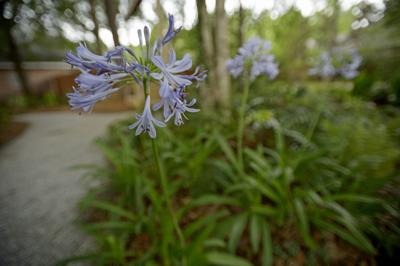The leaves of my agapanthus plants are burned from the drought. Is now the time to cut them back, and, if so, how far? — Henry
Agapanthus leaves always show stress in late summer as the leaf ends turn yellow and brown. The main issue is heat, not drought. Agapanthuses are quite drought-tolerant. Indeed, if you water them too generously, you can cause root rot. While they are not happy with our typical summer temperatures in the 90s, they recover and come back beautifully in the spring — blooming for us around May ever year.
This past summer, however, was not typical. Neither we nor our agapanthuses have ever experienced so many days over 100 degrees. This unusual heat really affected the agapanthuses, and they look far worse this year than usual.
Feel free to trim back the unattractive foliage now. Try to retain as much green tissue as you can — the lower parts of the leaves may still be green. I’m very hopeful they will recover as they usually do, but I’ve seen some planting that look really bad. Time will tell.
I have a few crape myrtle trees and love them dearly. My only problem is that there are all of these little branches that grow at the bottom of the tree, at the ground level. I cut them back, but they continue to grow. Is there anything that I can put on the fresh cuts that would stop all of this growth at the bottom of the tree? — Jenna Palmer
It seems that crape myrtles are trees with aspirations to be big shrubs. Leave a crape myrtle tree alone, and eventually most will send up lots of shoots from the base and turn into something looking more like an overgrown shrub than a tree. To maintain a pleasing tree shape, we regularly remove these shoots — called suckers — from the base of the trunk.
Remove suckers regularly as soon as they appear. They are easier to deal with and cause less damage to the tree when they are removed early. Prune them all the way back to their point of origin at the trunk or a root. Make a flush cut. Do not leave a stub or several suckers will appear for each one you cut off.
To prevent suckers from growing back so fast, treat the freshly cut spots with a product such as Monterey Sucker Stopper or Bonide Sucker Punch (some nurseries may carry these, or you can order online). With proper management over time, you can keep suckers under control. Older trees tend to produce fewer suckers and don’t require so much attention.
I have a problem with bahiagrass in my centipede lawn. It has gotten significantly worse during the hot, dry weather this summer. I’m wondering if there is a weed killer I can spray on my lawn that will kill the bahiagrass without hurting my centipede grass. — Don Murray
Bahiagrass is an excellent pasture grass grown for hay, but it has no place whatsoever in a home lawn. I noticed that the heat and drought this summer did not affect bahiagrass as badly as it did our lawn grasses. As a result, it was able to spread in lawns where the lawn grass was stressed and not growing as it normally would.
One of the most irritating things about bahiagrass in a lawn is its rapid production of flower stalks. Within a few days after mowing, the bahiagrass flower stalks pop up and make the lawn look untidy. These flower stalks are the best way to identify bahiagrass. At the top of the stalk, it splits and the flower heads form a distinctive V shape.
Fortunately, the herbicide metsulfuron (MSM Turf) is labeled to control bahiagrass in lawns. It is labeled for use on centipede, St. Augustine, Bermuda and zoysia.
GARDEN TIPS
GOING TROPICAL: If you intend to add tropical plants to your landscape, plant them as soon as possible. This includes popular plants like tropical hibiscus, tibouchina, bird of paradise, philodendron, ixora, firebush and others. Tropical plants that are well established are more likely to survive harsh winter weather, such as freezes.
READY TO SHED: As we move into the fall, do not be concerned about the declining health of deciduous tree (those that drop their leaves in winter) and shrub foliage. You will begin to see leaf spots, scorched edges, yellow leaves and other symptoms. These trees and shrubs are getting ready to shed their leaves, and the spots and blemishes are just part of the process.
COMBAT DRYNESS: The weather is dry now. Be sure to check lawns, shrubs, flowerbeds and vegetable gardens and water deeply and thoroughly as needed.
ON THE DOTTED LINE: Azalea lace bugs feed from the underside of the leaves causing small, white dots on the upper side of the leaves and dark brown spots on the back. If you see these symptoms, spray two or three times under the leaves with permethrin, bifenthrin or a light horticultural oil following directions on the label. After treatment, the white dots will persist but not get worse.
Garden columnist Dan Gill answers readers' questions each week. To send a question, email Gill at dgill@agcenter.lsu.edu.


